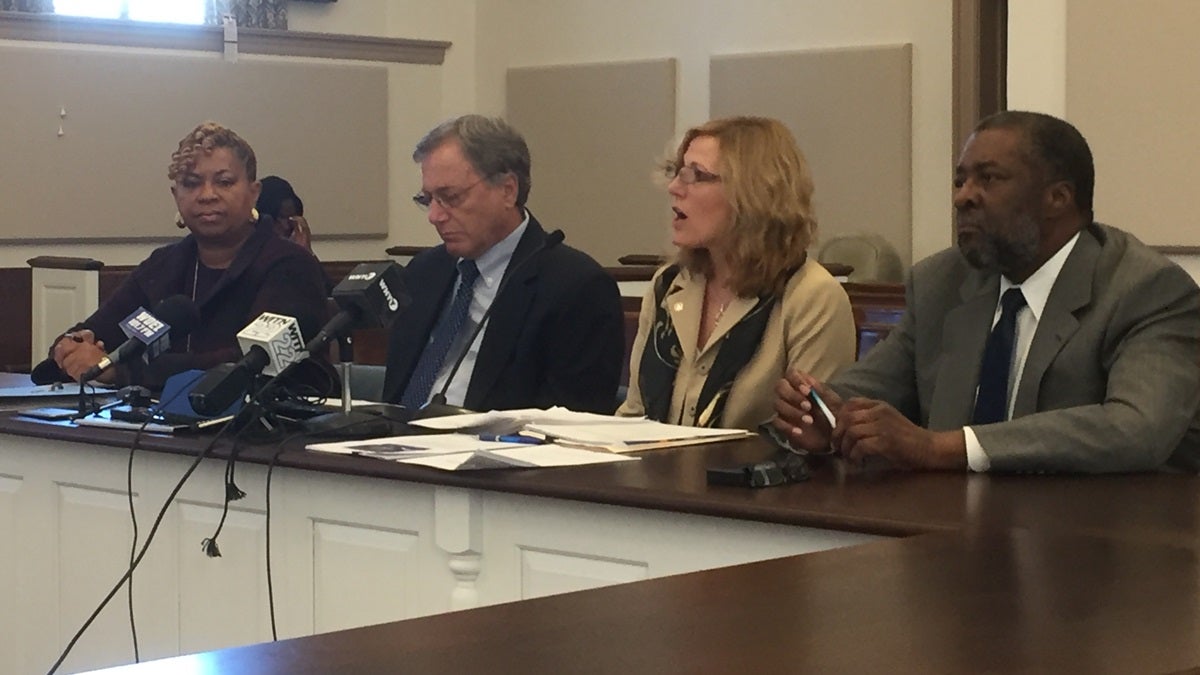CDC report: Abuse, poverty, addiction spurs Wilmington violence

DHSS Secretary Rita Landgraf joins state and city leaders to unveil the CDC report on Wilmington violence Tuesday morning. (Zoe Read/WHYY)
A federal study of violence in Wilmington shows a pattern of poverty, abuse and addiction as common factors among violent criminals.
Delaware health officials hope to curb gun violence in Wilmington by using risk assessment data to help them intervene before a person commits a gun crime. On Tuesday, the Delaware Department of Health and Social Services released a city gun violence study conducted by the Centers for Disease Control and Prevention.
Officials say Delaware is the first state to conduct this kind of study, which takes a public health and social services perspective on gun violence, and offers recommendations on how to prevent gun incidents through preventative measures.
“Violence is an issue that affects all of us. Therefore the responsibility to stop the cycle of violence, to find meaningful solutions, sustainable solutions and intervene early belongs to all of us,” said Delaware Secretary of Health Rita Landgraf.
“We cannot arrest our way out of this problem.”
In 2013, Wilmington had 127 shooting incidents, resulting in 154 victims—this was nearly a 45 percent increase over the previous two years. In recent years, the growth in Delaware’s homicide rate also has overtaken that of every other state, according to the CDC.
Wilmington City Councilwoman Hanifa Shabazz, D-Wilmington, proposed a resolution in December 2013 requesting the CDC investigate gun violence in the city.
Mayor Dennis Williams, D-Wilmington, made the official request for CDC assistance in January 2014, and the Division of Public Health formally requested the CDC’s assistance in June of that year.
The study looks at medical, child welfare, criminal, employment and educational records from 2000 to 2014 to determine what factors make a person at-risk for committing a gun crime.
The results showed the majority of individuals involved in gun violence were young men with a history of poverty, abuse, family addiction, or a lack of education or employment.
Almost half of those involved in gun crimes were previously victims of crimes themselves, and 13 percent of those individuals visited an emergency room with a gunshot wound.
“Exposure to violence and victimization leads to violence and victimization,” Landgraf said.
The individuals also faced a troubled childhood—many were investigated as victims of maltreatment, were in juvenile detention, received health or care services, or were suspended or expelled from school.
In adulthood, 86 percent were unemployed in the quarter preceding the crime, and many sought unemployment services.
Shabazz said she wasn’t surprised that indicators like poverty and unemployment contribute to gun crimes, but she was shocked that while these individuals faced various services, like child welfare and social assistance, there was no intervention.
She said she’s urging Gov. Jack Markell, D-Delaware, to issue an executive order that would take action to address root causes of violence.
“There were so many times there was an opportunity for intervention to occur before the person got to the point of committing the crime with a gun,” Shabazz said. “That is so disheartening to me and it demonstrates we are in a state of emergency when dealing with public health.”
Mayor Dennis Williams, D-Wilmington, also made a statement in response to the report.
“The report indicates that all community stakeholders must begin exploring a preventative approach as we respond to violent crime,” he said. “Policing should only represent one area of a comprehensive strategy to attack gun violence, but we must also proactively target and provide the necessary services to those individuals who are most likely to become violent offenders in the future.”
If agencies can understand the pattern that led to an individual committing a gun crime, they are more able to figure out what educational, social and economic services are needed to prevent that crime in the future.
“It gives us not only the tool scientific with the data, but it gives us an ability to look at our level of intervention and how we could intervene earlier and how we can collaborate across these systems,” Landgraf said.
“Our goal will be how do we intervene before they land in the criminal justice system or become perpetrators of violence?”
The CDC recommends an increased collaboration between the various social services agencies to share data between each agency.
It also suggests focusing the risk assessment on the youth population so they can experience lifelong benefits from prevention programs.
Finally, the CDC recommends the establishment of a community advisory board to provide recommendations on evidence-based, wraparound services to provide to high-risk youth.
“I do appreciate the community task force, that the community is coming to the table to have an input on what they feel is necessary, but I don’t want it to be another task force that will take two or three years to come up with some plan of action,” Shabazz said.
Landgraf said the state would determine the programs that are most in need and are successful, and fund those programs. Shabazz also said the state would save money in the long-term.
“We’re spending $38,000 a year on prison, and look at the money being spent on funerals, family distress and trauma, on property damage, for loss of business,” she said. “So spend money in a way that will address this scientifically proven epidemic plaguing our community.”
Dr. Paul Silverman, associate deputy director for the health department, said the study is not meant as a replacement to law enforcement, but to provide a multifaceted approach to public health and social services in relation to violence.
“It’s really meant to get upstream and address the root causes of problems,” he said. “They’re both needed, they’re complimentary, but hopefully this will have a long term impact.”
WHYY is your source for fact-based, in-depth journalism and information. As a nonprofit organization, we rely on financial support from readers like you. Please give today.





